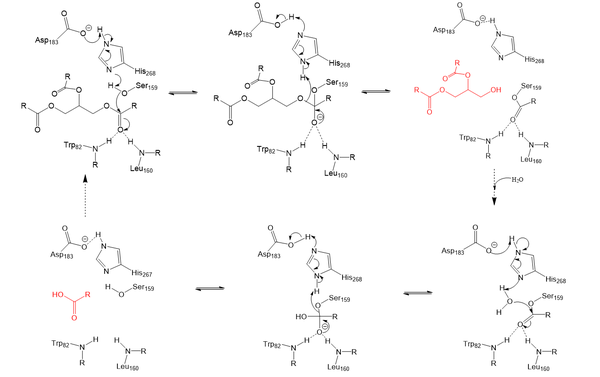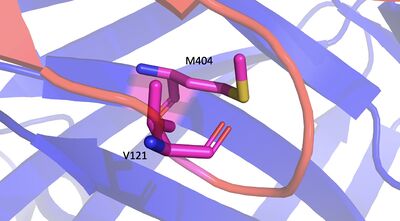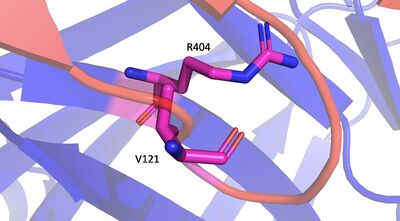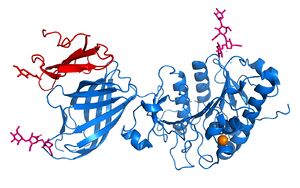User:Maggie Stopa/Sandbox 1
From Proteopedia
(Difference between revisions)
| Line 8: | Line 8: | ||
==Structural Overview== | ==Structural Overview== | ||
| - | <scene name='87/877513/Original_scene/1'>LPL</scene> is assumed to only be active as a <scene name='87/877513/Lpl_dimer/2'>homodimer</scene>, however, previous studies have argued that the lipase can be active in its <scene name='87/877513/Original_scene/1'>monomeric form</scene>. (https://www.ncbi.nlm.nih.gov/pmc/articles/PMC6442593/) The N-terminal domain of lipoprotein lipase is known to consist of an alpha/beta hydrolase domain, which is composed of six alpha helices and ten beta-strands. This domain creates an <scene name='87/ | + | <scene name='87/877513/Original_scene/1'>LPL</scene> is assumed to only be active as a <scene name='87/877513/Lpl_dimer/2'>homodimer</scene>, however, previous studies have argued that the lipase can be active in its <scene name='87/877513/Original_scene/1'>monomeric form</scene>. (https://www.ncbi.nlm.nih.gov/pmc/articles/PMC6442593/) The N-terminal domain of lipoprotein lipase is known to consist of an alpha/beta hydrolase domain, which is composed of six alpha helices and ten beta-strands. This domain creates an <scene name='87/877514/Alpha-beta_hydrolase_domain_1/1'>alpha/beta hydrolase fold</scene>. |
| + | The C-terminal domain of lipoprotein lipase is composed of twelve beta strands which form a "<scene name='87/877514/Just_barrel_domain_1/2'>barrel domain</scene>". | ||
==Mechanism== | ==Mechanism== | ||
| - | Lipoprotein Lipase functions to catalyze the hydrolysis of one [https://en.wikipedia.org/wiki/Ester ester bond] of triglycerides in order to remove one fatty acid tail and turn the triglyceride into a diglyceride. It does this by utilizing a simple [https://en.wikipedia.org/wiki/Serine_hydrolase serine hydrolase] mechanism, in which it uses a <scene name='87/877513/Catalytic_triad/ | + | Lipoprotein Lipase functions to catalyze the hydrolysis of one [https://en.wikipedia.org/wiki/Ester ester bond] of triglycerides in order to remove one fatty acid tail and turn the triglyceride into a diglyceride. It does this by utilizing a simple [https://en.wikipedia.org/wiki/Serine_hydrolase serine hydrolase] mechanism, in which it uses a <scene name='87/877513/Catalytic_triad/3'>catalytic triad</scene> composed of Asp183, His268, and Ser159 to catalyze the hydrolysis. His268 serves as a base catalyst by deprotonation of Ser159, which can then serve as the [https://en.wikipedia.org/wiki/Nucleophile nucleophile]. The transition state of the catalysis is stabilized by the backbone of Trp82 and Leu160 residues, forming the <scene name='87/877513/Oxyanion_hole_-_labeled/1'>oxyanion hole</scene>. The hydrolysis results in the formation of one free fatty acid and a glycerol with two fatty acid tails. |
[[Image:LPL_final_Mechanism.png|600 px|center|thumb|Serine hydrolase mechanism utilized by LPL to catalyze the breakdown of one ester bond of a triglyceride. Compounds colored red are the products of the hydrolysis.]] | [[Image:LPL_final_Mechanism.png|600 px|center|thumb|Serine hydrolase mechanism utilized by LPL to catalyze the breakdown of one ester bond of a triglyceride. Compounds colored red are the products of the hydrolysis.]] | ||
== Relevance & Disease == | == Relevance & Disease == | ||
| - | LPL is an extremely important enzyme, in that it breaks down triglycerides carried on [https://en.wikipedia.org/wiki/Very_low-density_lipoprotein VLDL], which leads to the reduction of [https://en.wikipedia.org/wiki/Cholesterol cholesterol] buildup. Cholesterol buildup is a very serious issue with regards to obesity in the United States. In addition to this, increased plasma triglyceride levels ([https://en.wikipedia.org/wiki/Hypertriglyceridemia hypertriglyceridemia]) is very unhealthy and is the leading cause of [https://my.clevelandclinic.org/health/diseases/16898-coronary-artery-disease Coronary Artery Disease] in America. LPL is an enzyme that helps combat this disease by breaking down the excess triglycerides that | + | LPL is an extremely important enzyme, in that it is responsible for the proper breakdown of certain fats in the body. LPL breaks down triglycerides carried on very low-density lipoproteins ([https://en.wikipedia.org/wiki/Very_low-density_lipoprotein VLDL]), which eventually leads to the reduction of [https://en.wikipedia.org/wiki/Cholesterol cholesterol] buildup. Cholesterol buildup is a very serious issue with regards to obesity and heart disease in the United States. In addition to this, increased plasma triglyceride levels ([https://en.wikipedia.org/wiki/Hypertriglyceridemia hypertriglyceridemia]) is very unhealthy and is the leading cause of [https://my.clevelandclinic.org/health/diseases/16898-coronary-artery-disease Coronary Artery Disease] in America. LPL is an enzyme that helps combat this disease by breaking down the excess triglycerides that cause blockage in the arteries of your heart. Very similarly, [https://medlineplus.gov/ency/article/000405.htm Chylomicronemia], which is defined as an excess of chylomicrons in the blood, results in a buildup of triglycerides and leads to similar diseases. Chylomicrons, otherwise known as ultra-low-density lipoproteins, carry digested fats in the form of triglycerides out of the small intestine and into the bloodstream. LPL recognizes the chylomicrons, resulting in the hydrolysis of triglycerides. Without LPL in the body, triglycerides are unable to get broken down, and there is a much higher likelihood of developing coronary & metabolic (liver & pancreas) based diseases. |
[[Image:M404_No_Mutation_copy.jpg|400 px|right|thumb|No Mutation Image]] | [[Image:M404_No_Mutation_copy.jpg|400 px|right|thumb|No Mutation Image]] | ||
| Line 23: | Line 24: | ||
=== GPIHBP1 === | === GPIHBP1 === | ||
Glycosylphosphatidylinositol-anchored high-density lipoprotein-binding protein ([https://en.wikipedia.org/wiki/GPIHBP1 GPIHBP1]) is necessary for <scene name='87/877513/Original_scene/1'>LPL</scene> function and stability. | Glycosylphosphatidylinositol-anchored high-density lipoprotein-binding protein ([https://en.wikipedia.org/wiki/GPIHBP1 GPIHBP1]) is necessary for <scene name='87/877513/Original_scene/1'>LPL</scene> function and stability. | ||
| + | GPI/LPL interface (w/labels): <scene name='87/877513/Hydrophobic_interface-labeled/1'>interface</scene> | ||
=== Calcium Ion Stabilization === | === Calcium Ion Stabilization === | ||
| + | Calcium ion stabilization:<scene name='87/877513/Calcium_stabilization_-labeled/1'>calcium ion stabilization</scene> | ||
| - | === Lid Region === | + | === Lid Region === |
| + | Lid: <scene name='87/877514/Lid_region_final/1'>Lid Region</scene> | ||
| + | [[Image:LLP11.jpg|300 px|left|thumb|LPL Image]] | ||
Revision as of 15:23, 26 April 2021
Lipoprotein Lipase LPL
| |||||||||||





